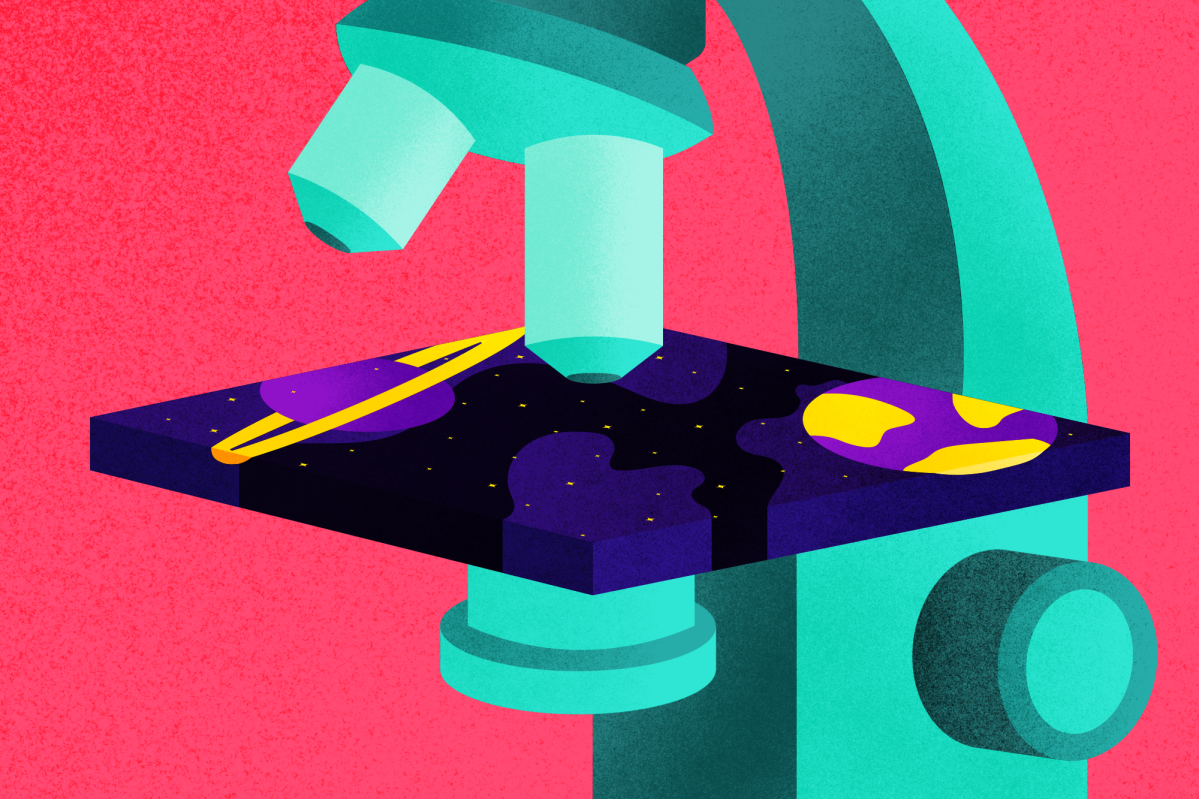
Perhaps the biggest question in astronomy right now is one that sounds simple: What is the universe made of? We know about protons, neutrons, and electrons, and we know these particles combine to create the universe we observe: Stars, planets, comets, and black holes.
But all of this is just a tiny fraction of what exists. Ordinary matter, what astronomers call baryonic matter, is in the minority when you look at our universe as a whole. The universe is in fact dominated by dark matter and dark energy, two mysterious things we’ve never detected directly.
To probe this strangest of puzzles, the European Space Agency (ESA) is building the Euclid space telescope, a cutting-edge project to investigate both dark matter and dark energy that will be launched in 2022.
To learn more about how you build a tool to search for something invisible, we spoke to René Laureijs, project scientist for Euclid.
Seeing only the effects
Both dark matter and dark energy are theoretical constructs, in that we have good reason to believe they exist, even though neither has ever been detected directly. Instead, we know they must be there because we see their effects on the universe.
“Dark matter is something you see only the effects of,” Laureijs explained. “So you see something moving, or things attracting each other, and you don’t know what’s causing it. We see it also in astronomy that things are attracted, or things are moving, and by looking at what’s going around, we cannot explain these movements by the presence of ordinary matter.”
This attraction is only really noticeable on very large scales, looking at objects the size of galaxies. At first, astronomers thought that maybe there was something wrong with their description of gravity, and that was why it looked different on astronomical scales. But they are now largely convinced it’s a particle causing these effects, although detecting the particle itself is an ongoing challenge. “We have never seen it, but we see indirect evidence for something that behaves like matter but cannot be seen. And that’s what we call dark matter,” Laureijs said.
And then there’s dark energy. It’s similar to dark matter in that it’s a construct used to explain unexpected observations about the universe. But it’s very different in that astronomers think it may be a form of energy, rather than a particle. It’s used to explain the expansion of the universe. We know that the universe is expanding, but observations in the 1990s from new tools like the Hubble Space Telescope shocked astronomers by showing that the rate of expansion was accelerating.
“This is the biggest puzzle we have at the moment in physics and astronomy.”
“It’s a very subtle effect, but by accurately measuring the distances to distant galaxies, people have discovered 20 years ago that the universe is not only expanding, but expanding in an accelerated way.” Laureijs explained. “That means there is an extra energy pushing the galaxies out, and it turns out that this acceleration started halfway through the age of the universe, about 6 billion years ago. That is really a puzzle, why that happened. So there is an extra force acting against gravity, pushing all the galaxies outwards in an accelerating way, and that’s what we call dark energy.”
What is really remarkable about dark matter and dark energy is just how prevalent they are. When considering the total energy component of the universe, current estimates show that around 68% of the universe is dark energy, while 27% is dark matter. All of the normal matter we see around us – every star, every planet, every molecule of gas – adds up to just 5% of all that exists.
So there’s 95% of the universe which we barely understand at all. “This is the biggest puzzle we have at the moment in physics and astronomy,” Laureijs said. “As an astronomer, it’s really great to be at this point in time, to work on this problem.”
How to hunt the invisible
The traditional method for searching for dark energy has been to measure the expansion of the universe by observing supernovae. If a supernova explodes in a distant galaxy, we can track the energy it gives off to estimate how far away it is – but there are limitations to this approach. So in recent decades, two new methods for measuring the expansion of the universe have been conceived, and Euclid will make use of both.
The first method is to look at the distribution of galaxies across the universe. Astronomers look at the distance to a galaxy and observe its redshift (the degree to which light from that galaxy is shifted to the red end of the spectrum), and from this they can work out how fast the galaxy is moving away from us.

The second method is to observe the distribution of dark matter. We know that the distribution of ordinary matter follows the distribution of dark matter, and there’s much more dark matter than ordinary matter out there. The gravitational effects of dark matter can be seen through a technique called gravitational lensing, in which the mass of the dark matter bends light around it.
This is why Euclid is searching for both dark matter and dark energy – because learning about one can also teach us about the other.
An incredible level of precision
To collect the kinds of data required to study dark energy and dark matter, the tools are conceptually relatively simple. Euclid has two primary instruments: An infrared camera/spectrometer, and a giant optical camera.
The infrared instrument has various filters and grating prisms that allow it to measure the redshift of distant galaxies, which shows how far they are moving away from us. The optical camera is a mosaic of 36 sensors that give a total resolution of over 600 megapixels, which results in extremely sharp images, like a much more precise version of a digital camera. And then there’s the telescope itself with its 1.2-meter mirror.
The challenge of building the hardware is the incredibly high level of precision required. The distortions that scientists are looking for due to the presence of dark matter and dark energy are so small that the instruments have to be incredibly sensitive, able to pick up even the tiniest fluctuations in readings. But that means that any change to the environment of the telescope itself can distort the data in a major way. Even something as small as turning on electronics within the satellite will be noticeable in the readings it takes.
“The telescope has been built in such a way that it is extremely stable and gives very sharp images,” Laureijs saidd. “And it has a very large field of view. If you put everything together – stable, sharp, and large field of view – you get an impossible design! So it’s very difficult.”
One way that the team approaches this design problem is by putting the telescope in space, where it will be in a far more stable environment and can capture images four to five times sharper than the sharpest image that could be captured from Earth. But there’s still the problem of sunlight, as adjusting the satellite relative to the sun will change how much heat it receives. Even a change of a few milliwatts of energy is enough to be detected by the instruments.

The biggest issue that telescope designers have to contend with is expansion. When materials get hot, they expand, and even a tiny fluctuation in temperature could cause parts of the telescope to swell and introduce distortions into the data.
As a result, most of the Euclid components are built out of a remarkable material called silicon carbide. This ceramic has an extremely low expansion coefficient, which means that it expands very little when it gets hot. And because it’s used throughout the instruments, if it does expand, it does so in an even way. Even the frames for the sensors are made of silicon carbide, as is the main mirror for the telescope. The mirror has been highly polished to a tolerance of a few nanometers, a process that took almost a year.
All of this care means that the satellite is extremely stable, and will be able to capture sharp, accurate images.
Offering something to humanity
While the study of dark matter and dark energy is mostly of importance to theoretical physics, the hunt can have practical implications as well. Firstly, the hardware that is designed for projects like Euclid and the measuring techniques that are developed could be used in a whole range of different fields. Secondly, there’s the rich wealth of data that Euclid will collect.
“With our data, we not only measure dark energy and dark matter, but we take pictures of everything we see in the sky on those wavelengths,” Laureijs said. “So there’s much more astronomy in it. And that is also an exciting part, because we offer something to humanity, to astronomers which is so new. Eight years from now, you can go to ESA’s website and go to any position in the sky and see how it looks, with enormous resolution, to a depth of 10 million years ago.”

Primarily, though, the search for dark matter and dark energy is about understanding how our universe operates on the most fundamental level, and answering a question that is utterly baffling right now: “What we see around us is only 5% of what there is in our universe. The other 95% is dark matter and dark energy, something we can hardly explain,” Laureijs said. “This is, for me, the fundamental reason that we do Euclid.”
It is this strange, inexpiable question of what the universe is made up of that drives scientists, engineers, and astronomers who work on dark matter. Because what we see around us is only scratching the surface of what exists out in the unknown.



